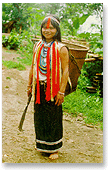Home » Ethnic People » Co
The Co People

You name it, and the Co are likely to have a song for it. The musical repertoire of this ethnic group is extensive, with folk songs singing of nature, bumper crops, daily activities and, of course, love. The Co live mainly in Tra Bong district, Quang Ngai province, and partly in Tra My district, Quang Nam province.
Having long since adopted a sedentary lifestyle, they are concentrated in villages on hillsides, close to streams or small rivers. There they grow manioc, Indian corn and cinnamon. The cinnamon grown in Tra Bong District has achieved world-wide renown since the early years of this century.
Previously, the Co lived in single longhouses on stilts called noc, but now they build houses on the ground as lowlanders do, and have a patriarchal society. What is heartening is that throughout their history of integration into a multiracial society, the Co have managed to preserve numerous distinctive cultural features – their customs, faith, festivals, folk art in general and folk music in particular.
It can be said that every few clans have succeeded in preserving so many types of folk songs as the Co – the xa ru, xa ru xa lia, a gioi, ca lu and the a lat, to name a few.
Each of them expresses a wide range of feelings. Xa ru praises the magnificent landscape and bumper crops; xa ru xa lia eulogises the love between young people and conjugal life; a gioi is an “alternative” way of singing about daily activities, reflecting the attitudes and sentiments of inhabitants regarding the societal and communal ties. Ca lu, a lat and a cheo are melodies to be sung at such festivals and rites as the celebration of bumper crops and the sacrifice of the water-buffalo.
These songs are accompanied by many traditional musical instruments including the b’ro, ca t’rot, ra ngoai and a-map that have also been well preserved.
Even the instruments have a time and place to be played.
The ca t’rot is played by the fire in the morning to start a working day, the ra ngoay is played by youth of both sexes to express their love for each other, and a map is played by women to lull children to sleep or to instruct the little ones, and to express that a young girl in the family is in love. The ta lia, meanwhile, is performed on holidays and during hunting for game.
The percussion in Co music is supplied by a set of two gongs, one big and the other small, and a drum. The gongs are usually played on days of worship, the Lunar New Year’s Day, at house-warming parties, on wedding days, and on days that guests or welcomed or bidden farewell. The gongs are especially important in the water-buffalo sacrifice, the major festival or the Co. It is on this day that the young men show off their skills in playing the gongs with strong and fast rhythms, while the young women keep pace with the graceful ca d’hao dance around a long multi-coloured pole that is located near the water-buffalo and the fire.
So far, the Co have succeeded in maintaining their gongs sets. In Tra Bong District alone, all the 19 communes and 90 villages have their own team of gong players. But the problem is that they are not played alone, they accompany either the ca d’hao dance or the numerous folk songs. Very few people know the ca d’hao dance and fewer still know to play the ca t’rot and the ta lia instruments. In the Tra Bong commune, for example, only two septuagenarian women can play the a map.
Co music has played an important role in the nation’s freedom struggle as well.
A local official, Truong Ngoc Khang, told me: “In order to organize an uprising in Tra Bong District and Western Quang Ngai Province we took many tunes from different ethnic groups like the Co, H’re and the Ca doong to stir up patriotism. Unfortunately, only elderly people sing those songs nowadays, and only in karaoke bars.”
Now, even the traditional attire of the Co is worn only on festival days or other important occasions. The housing has changed, as has the clothing. But what of their music? Yes, these can be preserved by recording them on CDs and VCDs, and printing the lyrics of folk songs – but only the Co themselves can keep their traditions alive by incorporating them into their daily lives, and letting the songs blossom in their hearts.

